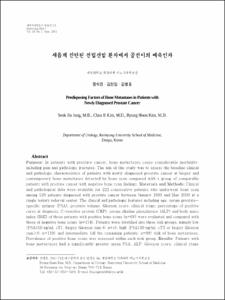새롭게 진단된 전립선암 환자에서 골전이의 예측인자
- Keimyung Author(s)
- Kim, Chun Il; Kim, Byung Hoon
- Department
- Dept. of Urology (비뇨의학)
- Journal Title
- Keimyung Medical Journal
- Issued Date
- 2011
- Volume
- 30
- Issue
- 1
- Keyword
- Bone metastases; Bone scan; Prostate cancer
- Abstract
- Purpose: In patients with prostate cancer, bone metastases cause considerable morbidity, including pain and pathologic fractures. The aim of this study was to assess the baseline clinical and pathologic characteristics of patients with newly diagnosed prostate cancer at biopsy and contemporary bone metastases detected by bone scan compared with a group of comparable patients with prostate cancer with negative bone scan findings. Materials and Methods: Clinical and pathological data were avaliable for 222 consecutive patients who underwent bone scan among 529 patients diagnosed with prostate cancer between January 1999 and May 2009 at a
single teriary referral center. The clinical and pathologic features including age, serum prostatespecific antigen (PSA), prostate volume, Gleason score, clinical stage, percentage of positive
cores at diagnosis, C-reactive protein (CRP), serum alkaline phosphatase (ALP) and body mass index (BMI) of those patients with positive bone scans (n=68) were evaluated and compared with those of negative bone scans (n=154). Patients were stratified into three risk groups, namely low (PSA<10 ng/ml, cT1, biopsy Gleason sum 6; n=4), high (PSA>20 ng/ml, cT3 or biopsy Gleason sum≥8; n=119) and intermediate (all the remaining patients; n=99) risk of bone metastases. Prevalence of positive bone scans was assessed within each risk group. Results: Patients with bone metastases had a significantly greater mean PSA, ALP, Gleason score, clinical stage (p<0.001), prostate volume (P=0.001), CRP (p=0.015), percentage of positive cores (p=0.030)
and age (p=0.044). When patients were stratified according to baseline characteristics, a 0%,
8.1% and 50.5% positive bone scan rate was found in patients with low, intermediate and high risk
prostate cancer, respectively (p<0.001). Conclusions: The rate of bone metastases was high
(30%) in contemporary patients with newly diagnosed prostate cancer. Presence of positive bone
scan can be predicted based on PSA, ALP, Gleason score, clinical stage, prostate volume, BMI,
percentage of positive cores, age and CRP. The Prevalence of bone metastases is relatively high
in patients with intermediate risk prostate cancer though each PSA, clinical stage, Gleason score
is not high. Therefore, a bone scan should be recommeded in such cases.
- Alternative Title
- Predisposing Factors of Bone Metastases in Patients with Newly Diagnosed Prostate Cancer
- Publisher
- Keimyung University School of Medicine
- Citation
- 정석진 et al. (2011). 새롭게 진단된 전립선암 환자에서 골전이의 예측인자. Keimyung Medical Journal, 30(1), 61–66.
- Type
- Article
- Appears in Collections:
- 2. Keimyung Medical Journal (계명의대 학술지) > 2011
1. School of Medicine (의과대학) > Dept. of Urology (비뇨의학)
Items in Repository are protected by copyright, with all rights reserved, unless otherwise indicated.
